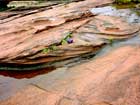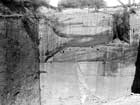| ENVIRONMENTS
- Deserts
Between 15
and 30 degrees latitude north and south of the equator lie the majority
of the world’s deserts. Arran drifted through a similar latitude between
290 and 250 Ma years ago during the Permian.
 Wind
blown sediment and sediment deposited by flash floods are typical of the
desert environment. The latitude alone was not the sole reason for the
desert like climate on Arran during the Permian; the supercontinent Pangea
had a more or less contiguous ring of mountains around its outer margins.
This helped to restrict the movement of moisture laden air into the continental
interior. For nearly forty Ma years Britain was a desert just like sub-Saharan
Africa is today Wind
blown sediment and sediment deposited by flash floods are typical of the
desert environment. The latitude alone was not the sole reason for the
desert like climate on Arran during the Permian; the supercontinent Pangea
had a more or less contiguous ring of mountains around its outer margins.
This helped to restrict the movement of moisture laden air into the continental
interior. For nearly forty Ma years Britain was a desert just like sub-Saharan
Africa is today
 Great
dunes of wind blown sand moved across Arran, creating a vast and desolate
landscape. Flash floods would cause more violent movements of sediment,
and the dune sands are often interbedded with breccias. The finest example
of aeolian sandstone can be seen at the Corrie shore (NR 963518) overlying
the Coal Measures of the Carboniferous. These rock exposures demonstrate
the large scale cross bedding associated with dune sandstones. Great
dunes of wind blown sand moved across Arran, creating a vast and desolate
landscape. Flash floods would cause more violent movements of sediment,
and the dune sands are often interbedded with breccias. The finest example
of aeolian sandstone can be seen at the Corrie shore (NR 963518) overlying
the Coal Measures of the Carboniferous. These rock exposures demonstrate
the large scale cross bedding associated with dune sandstones.
  If
examined with a hand lens, one may note that the grains of sand are exceptionally
rounded and smooth. They also have a frosted texture, gained through the
constant reworking of the sediment by the wind. If
examined with a hand lens, one may note that the grains of sand are exceptionally
rounded and smooth. They also have a frosted texture, gained through the
constant reworking of the sediment by the wind.
|

